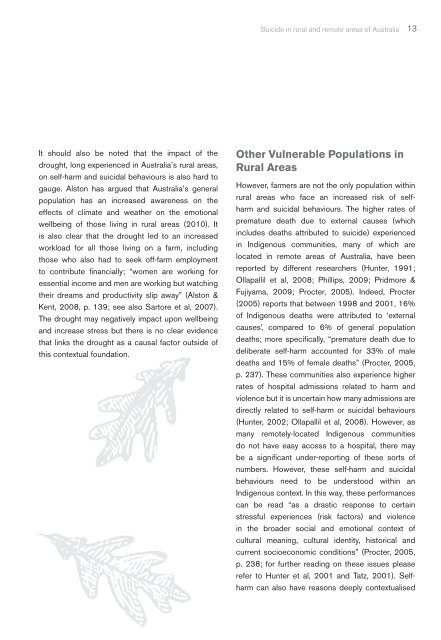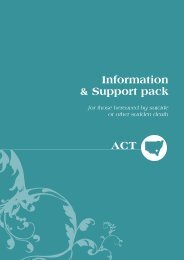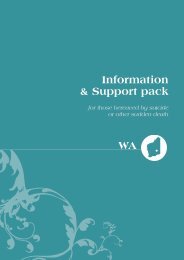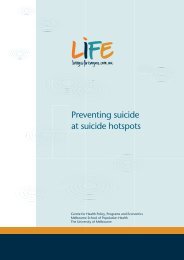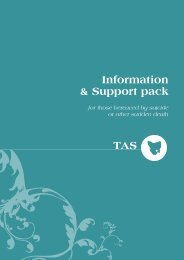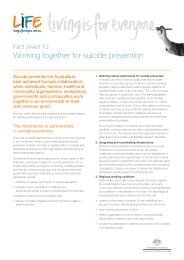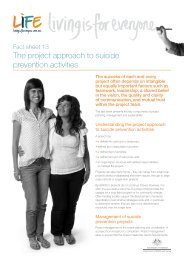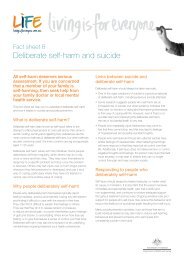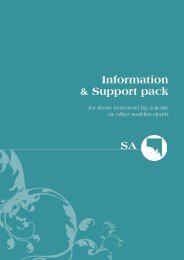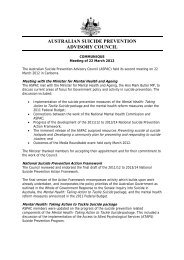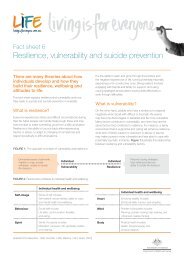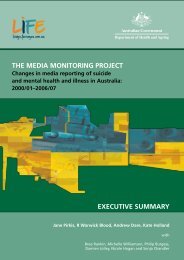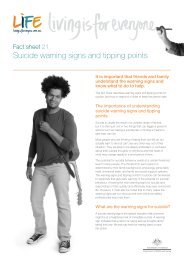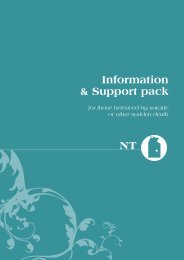SUICIDE in RURAL & REMOTE AREAS of AUSTRALIA - Living is for ...
SUICIDE in RURAL & REMOTE AREAS of AUSTRALIA - Living is for ...
SUICIDE in RURAL & REMOTE AREAS of AUSTRALIA - Living is for ...
You also want an ePaper? Increase the reach of your titles
YUMPU automatically turns print PDFs into web optimized ePapers that Google loves.
Suicide <strong>in</strong> rural and remote areas <strong>of</strong> Australia 13<br />
It should also be noted that the impact <strong>of</strong> the<br />
drought, long experienced <strong>in</strong> Australia’s rural areas,<br />
on self-harm and suicidal behaviours <strong>is</strong> also hard to<br />
gauge. Alston has argued that Australia’s general<br />
population has an <strong>in</strong>creased awareness on the<br />
effects <strong>of</strong> climate and weather on the emotional<br />
wellbe<strong>in</strong>g <strong>of</strong> those liv<strong>in</strong>g <strong>in</strong> rural areas (2010). It<br />
<strong>is</strong> also clear that the drought led to an <strong>in</strong>creased<br />
workload <strong>for</strong> all those liv<strong>in</strong>g on a farm, <strong>in</strong>clud<strong>in</strong>g<br />
those who also had to seek <strong>of</strong>f-farm employment<br />
to contribute fi nancially; “women are work<strong>in</strong>g <strong>for</strong><br />
essential <strong>in</strong>come and men are work<strong>in</strong>g but watch<strong>in</strong>g<br />
their dreams and productivity slip away” (Alston &<br />
Kent, 2008, p. 139; see also Sartore et al, 2007).<br />
The drought may negatively impact upon wellbe<strong>in</strong>g<br />
and <strong>in</strong>crease stress but there <strong>is</strong> no clear evidence<br />
that l<strong>in</strong>ks the drought as a causal factor outside <strong>of</strong><br />
th<strong>is</strong> contextual foundation.<br />
Other Vulnerable Populations <strong>in</strong><br />
Rural Areas<br />
However, farmers are not the only population with<strong>in</strong><br />
rural areas who face an <strong>in</strong>creased r<strong>is</strong>k <strong>of</strong> selfharm<br />
and suicidal behaviours. The higher rates <strong>of</strong><br />
premature death due to external causes (which<br />
<strong>in</strong>cludes deaths attributed to suicide) experienced<br />
<strong>in</strong> Indigenous communities, many <strong>of</strong> which are<br />
located <strong>in</strong> remote areas <strong>of</strong> Australia, have been<br />
reported by different researchers (Hunter, 1991;<br />
Ollapallil et al, 2008; Phillips, 2009; Pridmore &<br />
Fujiyama, 2009; Procter, 2005). Indeed, Procter<br />
(2005) reports that between 1998 and 2001, 16%<br />
<strong>of</strong> Indigenous deaths were attributed to ‘external<br />
causes’, compared to 6% <strong>of</strong> general population<br />
deaths; more specifi cally, “premature death due to<br />
deliberate self-harm accounted <strong>for</strong> 33% <strong>of</strong> male<br />
deaths and 15% <strong>of</strong> female deaths” (Procter, 2005,<br />
p. 237). These communities also experience higher<br />
rates <strong>of</strong> hospital adm<strong>is</strong>sions related to harm and<br />
violence but it <strong>is</strong> uncerta<strong>in</strong> how many adm<strong>is</strong>sions are<br />
directly related to self-harm or suicidal behaviours<br />
(Hunter, 2002; Ollapallil et al, 2008). However, as<br />
many remotely-located Indigenous communities<br />
do not have easy access to a hospital, there may<br />
be a signifi cant under-report<strong>in</strong>g <strong>of</strong> these sorts <strong>of</strong><br />
numbers. However, these self-harm and suicidal<br />
behaviours need to be understood with<strong>in</strong> an<br />
Indigenous context. In th<strong>is</strong> way, these per<strong>for</strong>mances<br />
can be read “as a drastic response to certa<strong>in</strong><br />
stressful experiences (r<strong>is</strong>k factors) and violence<br />
<strong>in</strong> the broader social and emotional context <strong>of</strong><br />
cultural mean<strong>in</strong>g, cultural identity, h<strong>is</strong>torical and<br />
current socioeconomic conditions” (Procter, 2005,<br />
p. 238; <strong>for</strong> further read<strong>in</strong>g on these <strong>is</strong>sues please<br />
refer to Hunter et al, 2001 and Tatz, 2001). Selfharm<br />
can also have reasons deeply contextual<strong>is</strong>ed<br />
GriffithBook FINAL 20/09.<strong>in</strong>dd 13<br />
15/11/12 4:28 PM


